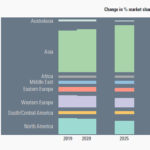 As building digital infrastructure supporting resilient operations becomes a key priority due to the pandemic, the publishing houses in India are re-assessing their plans of distribution of content keeping in view the rising prominence of e-content and online learning.
As building digital infrastructure supporting resilient operations becomes a key priority due to the pandemic, the publishing houses in India are re-assessing their plans of distribution of content keeping in view the rising prominence of e-content and online learning.
As we are in the middle of a pandemic outbreak, it is very difficult to estimate its long-term effects. Even though our society has been hit by several pandemics in the past, it is still quite tough to foresee the long-term economic, behavioral, or societal consequences of the ongoing pandemic.
The lockdown imposed due to the pandemic has affected almost every industry in the world economy. It is no wonder that first phase of the recent lockdown particularly has posed pertinent challenges for the publishing industry. The continued closure of schools and other educational institutions due to the lockdown has dealt a blow to the textbook industry, with booksellers and publishers experiencing an unprecedented decline in their business after decades of robust growth.
Evolving in Newer Directions
As published in HT, according to the reports of India Book Market by Nielsen released in 2015, there were about 21,000 book retailers and about 9,000 publishers in India, out of which 8,107 published books for schools, colleges and higher educational institutions. Educational books took up about 70% of the book market in India — with the school and college books market valued at Rs. 18,600 crore and Rs. 5,600 crore respectively in 2013–14. According to the report, the K-12 books market was likely to grow at a compound annual growth rate of 19.6%, from Rs. 22,170 crore in 2014-15 to Rs. 54,190 crore by 2019-20.
However, in this otherwise thriving landscape of textbook publishing in India, which is one of the major segment within the whole publishing sector, the sales of some well-known publishers dropped 50% compared to last year.
Publishers were sitting on massive unsold stocks. Since the lockdown happened in March, the last-mile sales of books also suffered. Most publishers had dispatched the books to distributors or bookshops but a lot of stocks are still lying unsold with them. As reported in HT, nearly 30-40% stocks were returned.
Now with the approval of the National Education Policy (NEP) by the Union Cabinet, the publishers believe that it is a welcome move – ushering in an era which will bring transformational reforms in schools and higher education, with the goal to make “India a global knowledge superpower”. This will propel the demand for textbooks and journals, both at the students’ and the institutional levels.
 Navigating the challenges
Navigating the challenges
Many in the industry are of opinion that one of the major reasons for the fall in the textbook sales is also the fact that a large number of children of migrant workers in budget schools have gone back to their villages, and are unable to continue their education online.
Keeping these challenges in mind, Mr. Vikas Gupta, Managing Director, Wiley India asserts: “The future of publishing will depend on how well publishers can evolve and create a solution that can go up the value chain. Publishing is an important service, which makes an author’s content reach out to the masses in the best possible way through its distribution network, which comes at a cost.”
He further states, “When it comes to online content, the situation becomes even more alarming as people usually believe that online content is available for free and can be easily reproduced. All these aspects make publishing a daunting business proposition, and publishers are struggling to survive.”
Not so long ago, people generally preferred reading physical books over eBooks or audio books, but now considering hygiene issues there has been a significant shift in their choice in the last few months. Moreover, in the current state of things, the publishers contend that they have witnessed the online consumers to spend greater time on audio books and e-books.
Sharing industry insights on the changes brought due to lockdown and pandemic, Ms. Monica Malhotra Kandhari, Managing Director, MBD Group told: “The physical print and e-content side of the publishing industry will grow side-by-side as the large population in the country means that while the demand for physical books will not wane anytime soon; however, a major thrust in the publishing industry will be on e-content generation and distribution. For instance, academic books will continue to witness high demand while easier access to technology and the internet will spur the consumption of digital content.”
As we step into the post-coronavirus world, the publishers are re-thinking to find a balance between what worked before and what needs to happen to sustain well in the next normal. In this feature, Team Paper Mart interviewed two key publishing houses in India – MBD Group and Wiley India on how they are seeking to accelerate to create value-creating opportunities in the pandemic as there has been a notable rise in demand for online learning resources.

Paper Mart: What is the impact of COVID-19 on the publishing industry so far?
Vikas Gupta: While the pandemic has probably given more time to read more books, which should be a positive indication for the publishing industry; however, the fact is that the pandemic has hit the publishing industry just as it has impacted almost every business. The subsequent lockdown impacted the sales, printing, and production of books, thereby, pushing publishers to adapt to the evolving landscape of the publishing industry.
Also, the lockdown led to the adoption of digital as a mainstream mode of teaching and learning. The universities shifted from their traditional mode of teaching and embraced online education. In order to align effective educational strategy with the rapidly changing scenario, universities are now increasingly demanding digital learning solutions which include labs, courseware, and e-books. Moreover, stay at home learning is driving the need for digital courseware.
PM: What are your expectations from the Govt. with regards to support?
VG: It is fascinating to see how the pandemic has changed the status quo. Knowledge and content vetted by the experts, available to solve real-world problems has become the necessity. Research and researchers are in the spotlight, their academic journals are cited, and their editors are getting featured in media. The whole world is looking forward to researches that are being conducted on vaccine and cure of COVID-19, thus, making applied research an integral part of the economy. The need of the hour is to increase research funding to ensure quality research that will help solve the country’s niche problems.
Further, the COVID relief package issued by the Government gave a much-needed boost to bringing digital learning into the mainstream. For instance, QR code enabled books, and e-Vidya portal are ambitious, yet need of the hour projects. The key challenge maybe is around its speedy and quality implementation. Currently, the government’s spending on education in India is a mere 4.6% of the GDP, slating India as 62nd in the world. The NEP policy has increased it to 6 percent of the GDP; which will also be inadequate given the scale of digitization and research focus proposed. This is where a Public-Private partnership model can emerge. The role of publishers becomes very important here – we can partner with the government to make available updated, adaptive, and enriched books and learning materials for free distribution on government channels. The cost of development, distribution, and other economic activities on the part of the publishers can be allocated in the National Education Budget. This will bring equity in education across the country by ensuring access to all sections of our population.
PM: Will the NEP Policy 2020 stir back the market for the Indian book publishers? How helpful would this new policy be?
VG: The publishing landscape for higher education is large and diverse in India, with a high demand for books by a large chunk of the younger population for education and skill-enhancement purposes. The academic publishing represents the diverse needs of central, state, and privately funded institutions and research bodies, thereby making it uneven across the nation.
The New Education Policy will bring some fundamental changes to the current system. The aim to increase Gross Enrollment Ratio to 50% by 2035 by adding at least 3.5 crore new seats to higher education, bringing in international campuses in India, setting up universities and colleges in or near every district and making the current universities, research-focused universities, will open new opportunities for academic publishers. This will fuel the demand for books, both at the students’ and the institutional levels. Libraries will be required to expand their offerings, by not only purchasing more, but also inducting online courseware in their portfolio to support the online classrooms that the universities may adopt as mainstream. Increased focus on research will increase funding and encourage researchers to publish more academic journals. Also, Institutional restructuring and consolidation will end the fragmentation of higher education, thus, making it more uniform.
The future of publishing will depend on how well publishers can evolve and create a solution that can go up the value chain.
PM: How things will evolve in future?
VG: The future of publishing will depend on how well publishers can evolve and create a solution that can go up the value chain. Publishing is an important service, which makes an author’s content reach out to the masses in the best possible way through its distribution network, which comes at a cost. Thus, going forward, publishing will transform into a framework where content is free, but the services, delivery format and learning customization that publishers will build would have a premium price.
When it comes to online content, the situation becomes even more alarming as people usually believe that online content is available for free and can be easily reproduced. All these aspects make publishing a daunting business proposition, and publishers are struggling to survive. In this difficult scenario, publishers who recognize the importance of technology as an enabler will be able to succeed by:
(a) Generating unique value ideas using technology,
(b) Developing a viable learning ecosystem, and
(c) Providing new business models, with the remaining at risk of losing sooner or later.

Paper Mart: What is the impact of COVID-19 on the publishing industry so far?
Monica Malhotra Kandhari: The outbreak of the COVID-19 pandemic and the subsequent lockdown has resulted in the closure of schools across the country. Sales of textbooks have plummeted by as much as 50 percent and the sales of reference books also have been dismal. The lack of demand has not only impacted publishing houses, but also those in ancillary services such as stockists and distributors who have to deal with a slowdown in business while their operations costs such as electricity bills, rent, water bills and other statutory costs remain the same.
PM: What are your expectations from the Govt. with regards to support?
MMK: The government can and must extend all possible support to the publishing industry for its survival. The industry is facing serious liquidity issues and we hope the government to step in to mitigate the situation. Bringing out a stringent law on intellectual property and safeguard against piracy will help the industry immensely now and, in the future, as well. A resolution for the long-standing GST-related issues due to books being GST free while input material such as paper, ink, and logistics to be subjected to GST would help the industry as it looks for recovery from the crisis.
PM: Will the NEP Policy 2020 stir back the market for the Indian book publishers? How helpful would this new policy be?
MMK: The multi-disciplinary approach of New Education Policy 2020 and the focus on making India a knowledge superpower bodes well for the publishing industry. It is expected that the implementation of the policy will take at least two years and due to the lack of detailed curriculum guidelines, the publishers cannot start work at the ground level. The impact of the new policy would only be visible once we are in the implementation stage and the publishing industry will be an important catalyst in the new scheme of things to achieve the milestones of NEP. Moreover, the Government should allow every stakeholder to participate in the effective implementation of NEP.
PM: How things will evolve in future?
MMK: The physical print and e-content side of the publishing industry will grow side-by-side as the large population in the country means that while the demand for physical books will not wane anytime soon; however, a major thrust in the publishing industry will be on e-content generation and distribution. For instance, academic books will continue to witness high demand while easier access to technology and the internet will spur the consumption of digital content.
The physical print and e-content side of the publishing industry will grow side-by-side as the large population in the country means that the demand for physical books will not wane anytime soon.



